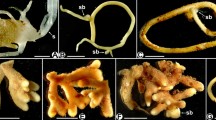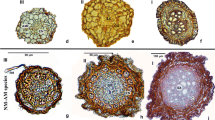Abstract
Species in the subfamily Monotropoideae (family Ericaceae) are achlorophyllous and myco-heterotrophic. They have become highly specialized in that each plant species is associated with a limited number of fungal species which in turn are linked to autotrophic plants. This study provides an updated and comprehensive examination of the anatomical features of two species that have recently received attention with respect to their host-fungal specificity. Root systems of Monotropa uniflora and Pterospora andromedea collected from the field were characterized by light microscopy and scanning electron microscopy. All roots of both species were associated with fungi, each root having a well-developed mantle, paraepidermal Hartig net, and intracellular “fungal pegs” within epidermal cells. The mantle of M. uniflora was multi-layered and numerous outer mantle hyphae developed into cystidia of two distinct morphologies. Large calcium oxalate crystals were present, primarily on the mantle surface. The outer mantle of P. andromedea was more loosely organized, lacked cystidia, and had smaller plate-like as well as cylindrical crystals on the surface and between outer mantle hyphae. Fungal pegs in M. uniflora originated from inner mantle hyphae that penetrated the outer tangential wall of epidermal cells; in P. andromedea, these structures were initiated either from inner mantle hyphae or Hartig net hyphae and penetrated radial walls of epidermal cells. With respect to function, fungal pegs occurred frequently in both host species and, although presumed to be the sites of active nutrient exchange, no direct evidence exists to support this. Differences between these two monotropoid hosts, resulting from the mycorrhizal fungi with which each associates, are discussed.





Similar content being viewed by others
References
Agerer R, Weiss M (1989) Studies on ectomycorrhizae. XX. Mycorrhizae formed by Thelephora terrestris on Norway spruce. Mycologia 81:444–453
Agerer R, Danielson RM, Egli S, Ingleby K, Luoma D, Treu R (eds) (1996–2002) Descriptions of ectomycorrhizae. Einhorn, Schwäbisch Gmünd, Germany
Bidartondo MI, Bruns TD (2001) Extreme specificity in epiparasitic Monotropoideae (Ericaceae): widespread phylogenetic and geographical structure. Mol Ecol 10:2285–2295
Bidartendo MI, Bruns TD (2002) Fine-level mycorrhizal specificity in the Monotropoideae (Ericaceae): specificity for fungal species groups. Mol Ecol 11:557–569
Campbell EO (1971) Notes on the fungal association of two Monotropa species in Michigan. Mich Bot 10:63–67
Cullings KW, Szaro T, Bruns TD (1996) Evolution of extreme specialization within a lineage of ectomycorrhizal epiparasites. Nature 379:63–66
Dexheimer J, Gérard J (1993) Application de quelques techniques cytochimiques à l’étude des interfaces des ectendomycorhizes de Monotrope (Monotropa hypopitys L.). Acta Bot Gall 140:459–472
Duddridge JA (1985) A comparative ultrastructural analysis of the host-fungus interface in mycorrhizal and parasitic associations. In: Wood DA, Frankland JC (eds) Developmental biology of higher fungi. (British Mycological Society symposium no. 10.) Cambridge University Press, Cambridge, pp 141–173
Duddridge JA, Read DJ (1982) An ultrastructural analysis of the development of mycorrhizas in Monotropa hypopitys L. New Phytol 92:203–214
Edwards HH, Gessner RV (1984) Light and transmission electron microscopy of English oak ectomycorrhizal short roots. Can J Bot 62:1327–1335
Hawksworth DL, Sutton BC, Ainsworth GC (1983) Ainsworth and Bisby’s dictionary of the fungi, 7th edn. Commonwealth Mycological Institute Kew, Surrey
Henderson MW (1919) A comparative study of the structure and saprophytism of the Pyrolaceae and Monotropaceae with reference to their derivation from the Ericaceae. Contrib Bot Lab Univ Pa 5:42–109
Kamienski FM (1882) Les organes végétatifs du Monotropa hypopitys L. Mem Soc Nat Sci Nat Math Cherb 24:5–40
Kernaghan G, Currah RS, Bayer RJ (1997) Russulaceous ectomycorrhizae of Abies lasiocarpa and Picea engelmannii. Can J Bot 75:1843–1850
Leake JR (1994) The biology of myco-heterotrophic (“saprophytic”) plants. Tansley review no. 69. New Phytol 127:171–216
Li CY, Massicotte HB, Moore LVH (1992) Nitrogen-fixing Bacillus sp. associated with Douglas-fir tuberculate ectomycorrhizae. Plant Soil 140:35–40
Lutz RW, Sjolund RD (1973) Monotropa uniflora: ultrastructural details of its mycorrhizal habit. Am J Bot 60:339–345
Martin J (1986) Mycorhization de Monotropa uniflora L. par des Russulaceae. Bull Soc Mycol Fr 102:155–159
Massicotte HB, Peterson RL, Ackerley CA, Ashford AE (1987) Ontogeny of Eucalyptus pilularis-Pisolithus tinctorius ectomycorrhizae. II. Transmission electron microscopy. Can J Bot 65:1940–1947
Massicotte HB, Melville LH, Li CY, Peterson RL (1992) Structural aspects of Douglas-fir [Pseudotsuga menziesii (Mirb.) Franco] tuberculate ectomycorrhizae. Trees 6:137–146
Massicotte HB, Melville LH, Molina R, Peterson RL (1993) Structure and histochemistry of mycorrhizae synthesized between Arbutus menziesii (Ericaceae) and two basidiomycetes, Pisolithus tinctorius (Pisolithaceae) and Piloderma bicolor (Corticiaceae). Mycorrhiza 3:1–11
Massicotte HB, Melville LH, Peterson RL, Molina R (1999) Biology of the ectomycorrhizal fungal genus, Rhizopogon. IV. Comparative morphology and anatomy of ectomycorrhizas synthesized between several Rhizopogon species of Ponderosa pine (Pinus ponderosa). New Phytol 142:355–370
Massicotte HB, Melville LH, Peterson RL, Molina R (2000) Comparative anatomy of ectomycorrhizas synthesized on Douglas-fir by Rhizopogon spp. and the hypogeous relative Truncocolumella citrina. New Phytol 147:389–400
Robertson DC, Robertson JA (1982) Ultrastructure of Pterospora andromedea Nuttall and Sarcodes sanguinea Torrey mycorrhizas. New Phytol 92:539–551
Schelkle M, Ursic M, Farquhar M, Peterson RL (1996) The use of laser scanning confocal microscopy to characterize mycorrhizas of Pinus strobus L. and to localize associated bacteria. Mycorrhiza 6:431–440
Smith SE, Read DJ (1997) Mycorrhizal symbiosis, 2nd edn. Academic Press, London
Snetselaar KM, Whitney KD (1990) Fungal calcium oxalate in mycorrhizae of Monotropa uniflora. Can J Bot 68:533–543
Young BW, Massicotte HB, Tackaberry LE, Baldwin QF, Egger KN (2002) Monotropa uniflora: morphological and molecular assessment of mycorrhizae retrieved from sites in the sub-boreal spruce biogeoclimatic zone in central British Columbia. Mycorrhiza 12:75–82
Acknowledgements
We thank Linda Tackaberry for her editorial skills, J. Catherall for allowing us to use Fig. 4, and two anonymous reviewers for helpful comments. The Natural Sciences and Engineering Research Council of Canada provided financial support to R. L. P. and H. B. M.
Author information
Authors and Affiliations
Corresponding author
Rights and permissions
About this article
Cite this article
Massicotte, H.B., Melville, L.H. & Peterson, R.L. Structural features of mycorrhizal associations in two members of the Monotropoideae, Monotropa uniflora and Pterospora andromedea . Mycorrhiza 15, 101–110 (2005). https://doi.org/10.1007/s00572-004-0305-6
Received:
Accepted:
Published:
Issue Date:
DOI: https://doi.org/10.1007/s00572-004-0305-6




